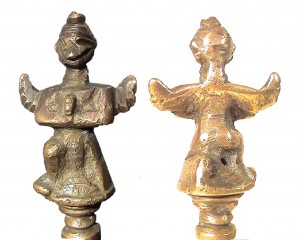Update on the Mysterious Bell Found in Coal
(originally published in Creation Matters, Vol. 18, No. 6, November/December, 2013.)
The Genesis Flood was an act of judgment, purposely sent to destroy the wicked civilization of Noah’s day (Genesis 6:5–7). It could well be that the entire inhabited region of the early earth (likely a single continent at the time) was resurfaced and all traces of human activity wiped clean or buried under masses of sedimentary rock. Therefore, it should not seem strange that we find almost no trace of the civilization of long-lived patriarchs mentioned in the beginning of Genesis.
In his classic article entitled Where are All the Human Fossils?, Snelling (1991) reviewed flood realities like human mobility, the destructive power of the flood waters, and differential suspension. Then he wrote: When we take all these factors into account, it would seem unlikely that many of the people present at the time the Flood waters came could have ended up being fossilized. Even if a handful, perhaps a few thousand, were preserved, when such a small number is distributed through the vast volume of Flood sediments, the chances of one being found at the surface are mathematically very, very low, let alone of being found by a professional scientist who could recognize its significance and document it properly.
There have been many promising stories about the discovery of pre-Flood giant skeletons, antediluvian artifacts, and even the ark itself. Typically, the end result of these stories is disappointment. So it is important to employ caution and objectivity regarding such claims. It is easy, even for trained scientists, to make observational mistakes, or to jump to conclusions too quickly when presenting a dramatic find to bolster their own arguments.
The historical accuracy of God’s Word has been demonstrated many times, and Christians do not need artifacts to substantiate their faith. The Bible says, “So then faith cometh by hearing, and hearing by the word of God” (Romans 10:17). Nonetheless, it is intriguing to investigate an archaic implement that might provide clues about the world before the Flood. We seek to glorify God by harmonizing the revealed truth of Genesis with appropriate scientific research, seeking to understand His original creation.
Newton Anderson and the bell
One such discovery worthy of further study is that of a bell which was found imbedded in a lump of coal by Newton Richard Anderson. The circumstances surrounding this event and subsequent investigations of the bell by various entities are described herein, based primarily on my recorded interview of Mr. Anderson on January 20, 2007, and a phone conversation May 19, 2013.
In 1944, as a ten-year-old boy, Anderson’s task was to keep the coal furnace stoked at his home in Buckhannon, West Virginia (WV). One evening he went into the basement to refuel the furnace and carried a particularly large lump of coal on his shovel. As he carried the loaded shovel, it wobbled and the coal fell onto the floor, breaking the lump in two. A slender metallic object was revealed, protruding from one of the broken halves. Newton set aside the piece with the curious object and placed the remainder into the furnace.
Over the next couple of days the boy extracted a small bell from the coal, first by whacking it with a croquet mallet and then by cleaning it with lye and a scrub brush. Unfortunately he scoured all the coal off
the intriguing artifact! But his parents and others witnessed the bell that he brought up from the basement and it became an object of conversation, residing on an old secretary desk shelf.
Eventually the “bell found in coal” became somewhat famous, being featured in creationist and apologetics books (see for example Sharbaugh, 1997). An evangelistic tract was made that presented the bell as indisputable proof of the worldwide deluge. Ripley’s “Believe it or Not” found out about the bell and sent a representative to investigate. Anderson was interviewed and the bell was prominently featured in the 1992 CBS docudrama production called Ancient Secrets of the Bible. Creationist books and articles continue to describe this mysterious bell, touting it as a genuine antediluvian artifact (see for example Morris, 2008). The bell was even displayed at the San Diego Museum of Natural History for a couple of years, and they made an offer to purchase it.
West Virginia coal
In the 1940’s a neighbor named Carl Hoylman delivered coal to the Anderson household. He negotiated with landowners to extract the coal, mined it, sold it, and delivered it. The bituminous coal found in West Virginia’s Upshur County is dated as Carboniferous Period and Pennsylvanian Epoch, which is supposed to have lasted from roughly 323 to 298 million years ago (Anonymous, 1997). Obviously, a discovery like that of the bell would present a serious problem for the evolutionary timescales. How is it possible that a bronze bell could be found in coal that was formed before the dinosaurs had even evolved?
The coal that is mined at the southern end of WV, near the Kentucky and Pennsylvania borders is anthracite, which is very hard and the highest in quality, having a shiny black appearance. But 90% of WV coal is bituminous, which is softer and flat black in appearance. Yet another type of WV coal is lignite, an even softer, brown coal with less carbon content. Anderson declared that he wouldn’t have even tried to burn the lump if it was brown. They probably would have thrown it away. Thus, the bell was most likely found in a lump of black coal, probably bituminous.
Analysis of the bell

Figure 2. Front and back view of the bell’s figurine.
In the 1963–1964 timeframe, a man named Boris Bilas took the bell to the geology department at the University of Delaware at Wilmington, where it was studied and then returned. They confirmed that the bell was handmade. Anderson eventually moved to Florida and became a chemistry teacher. In 1973 he attended a presentation by Dr. John Morris of the Institute for Creation Research and brought the bell to John’s attention. Morris analyzed the artifact in the lab at the University of Oklahoma. He subsequently wrote (Morris, 2010), “Nuclear Activation Analysis determined it to be primarily of bronze with a curious admixture of zinc. A micro probe showed no residual traces of coal.”
The fact that the bell’s metallurgical fingerprint is odd should not be surprising if, indeed, the bell is from pre-Flood times. It would not necessarily be expected to match any mix of known, post-Flood metal workings. The clapper inside the bell is composed of iron and it still rings beautifully. Genesis 4:22 states that Tubal-Cainwas “an instructor of every artificer in brass and iron…” These then were two of the metals with which craftsmen worked in the pre-Flood economy.
Polygraph testimony
As a creationist speaker I became intrigued by the story of the bell and managed to track down Newton Anderson in Greenville, SC. After some discussions I agreed to acquire the fascinating artifact from Anderson, but requested that he take a lie detector test to further validate his story. In 2007 I hired Stan Fulmer, an expert polygraph specialist who worked on death row cases. Anderson was found to be credible and he clearly passed the test. The polygraph examination report can be viewed online (Fulmer, 2007).
The figure atop the bell

Figure 3. A Garuda bell referenced by Hudson (2010) for its figurine’s similarities to the bell found in coal. Image downloaded from Hudson (2010).
Anderson spent a great deal of time researching the demon-like figure positioned atop the bell (Figure 2), sending inquiries to multiple universities. He discovered similarities to Pazuzu, the Babylonian Demon of the Southwest Wind, and the Hindu deity Garuda. Both the Babylonian Demon and the bell figurine have a telltale horn on their heads (partially broken off on the bell). Their narrow faces are eerily alike. Garuda (a beaked, flying god) is sometimes depicted on top of bells, as is the Egyptian winged goddess Isis.
The wings and kneeling posture of the bell figurine are typical of the Garuda. Certain worship seems to take on similar forms in various cultures (like the Venus figures from disparate lost cultures and the ancient fascination with pyramids), which doesn’t necessitate that they were culturally related. Perhaps a spirit being (maybe even named “Pazuzu” or “Garuda”) was worshiped by a pre-Flood cult. After the earth’s populations began to grow again, this same spirit could have inspired similar religious worship in the Orient during more recent times. Critics of the bell artifact have seized on the similarity to Garuda bells (Figure 3) to suggest that the Anderson bell is of modern origin. A typical argument along these lines is presented by Hudson (2010). He argues that the bell is a Garuda bell, made of brass that could have come from pieces of scrap metal remanufactured by an artisan in India or elsewhere in Asia. He goes on to say: “All we have is the testimony of one person who says he found the bell when he was ten years old (over 60 years before he took the polygraph test). Polygraph tests are unreliable because they only tell us if someone thinks they are lying and there is no doubt that Mr [sic] Anderson believes he is telling the truth. Another intriguing possibility is that the bell appeared to be in coal but was actually in a concretion of coal slurry and coal lumps hardened over time so that it appeared to be inside a contiguous lump of coal.”
Hudson presents a far-fetched scenario in which someone carried a Garuda bell from the Far East up into the mountains of West Virginia. Then it was accidentally dropped onto an exposed vein of coal, such that a coal slurry would quickly gather around it (before it could be contaminated with dirt, leaves, and such). A coal slurry consists of coal dust, particles, and water that is typically a by-product of coal mining. The slurry then completely buried the bell and eventually dried, hardening into a pure coal concretion that appeared to be a solid lump of coal when it was later mined!
Anderson responded to this hypothesis by reminding me that the bell was not found in lignite (soft, brown coal), but came from a block of hard, black coal. Moreover, he was unaware of anyone in his community that was Hindu, of Indian descent, or had traveled to the Far East and returned with any artifacts.
Discovering the mine
Not very long ago I had the opportunity to speak for a series of creation meetings in Clarksburg, WV. As might be expected, there was considerable interest from the audience when I discussed the Genesis Flood and presented the bell found in coal. A local realtor agreed to assist in identifying the location of the actual mine from which the bell-containing coal would have been mined. It is important to note that there were two primary types of coal mining procedures common in the area during the 1940’s, surface mining and underground mining. If the coal seam was close to the surface (typically a flat topography), the dirt and rock overburden could be easily stripped away and the coal harvested. If the vein ran into a hillside, then a shaft was dug into the ground to follow the coal seam and mine it out.
After considerable research into property records and walking lots, the realtor was able to find the location of Carl Hoylman’s dilapidated old mine (Figure 4) and even the remnants of his decaying coal wagon. This particular mine location tapped into coal from the Redstone Coal Seam, which is clearly composed of bituminous coal (USGS, n.d.). It is often found underground at depths of 100 feet. This information is helpful in testing the viability of Hudson’s scenario (Hudson, 2010). If the coal had been mined on the surface, then it would be slightly more reasonable that the bell might have fallen into an exposed coal seam. But the reality is that the mine was far underground, making the critic’s just-so story a combination of whopping unlikelihood stacked upon impossibility! How is it possible for an artifact to fall into an underground coal seam, there to be encased in a slurry such that it becomes part of a large block of solid, black coal?
Bronze implements could easily survive for the roughly 4,000 years from the Flood to the present. Moreover, one can speculate that when civilization came to an end in the Flood, one of the bells made prior to the Flood was buried with a floating mass of vegetative debris that would later become WV coal, and finally end up, thousands of years later, in Newt Anderson’s coal bin.
Conclusion
There is no doubt that the best-case scenario for a pre-Flood artifact would be to have evidence which has been documented insitu by a professional scientist. Lacking that, the mysterious “bell found in coal” is perhaps the best candidate we have for an antediluvian artifact. The story behind its finding has been related by its discoverer, Newton Anderson, who appears to be a credible witness. The workmanship and authenticity of the bell have been examined. The probable location of the original mine was established, essentially ruling out claims by critics that the artifact is of modern origin.
From a creationist worldview, it certainly seems reasonable that the bell could be the work of an antediluvian artificer like Tubal-Cain (Genesis 4:22). Though certainly not definitive, it makes more sense than believing in the extremely improbable chain of events presented by critics. It is clear that a bell emplaced in Carboniferous coal would present a serious challenge to the evolutionary timeline.
References
Anonymous. 1997. Geological Map of West Virginia. West Virginia Geological and Economic Survey, p. 1.
Fulmer, L.S. 2007. Report on polygraph examination. GenesisPark.com. Retrieved May 16, 2013, from www.genesispark.com/wp-content/uploads/2011/10/bell_polygraph.jpg
Hudson, G. 2010. The mystery of the bell found in coal. Gordon’s Blog. Retrieved October 15, 2013, from www.ecalpemos.org/2010/07/mystery-of-bell-found-in-coal.html
Lotz, C.W. 1970. Probable Original Minable Extent of the Coal Seams of the Redstone Coal. West Virginia Geological and Economic Survey. (USGS National Geological Map Database, Product Description Page) Retrieved May 20, 2013, from http://ngmdb.usgs.gov/prodesc/proddesc_42193.htm
Morris, J. 2008. The Young Earth: The Real History of the Earth—Past , Present, and Future. Master Books, Green Forest, AR, p. 75.
Morris, J. 2010. An amazing anomalous fossil. Acts & Facts 39(2):16.
Sharbaugh. N. 1997 Ammunition for Piercing the Armor of the Philosophy of Evolution. Norm Sharbaugh Ministries, Brownsburg, IN, p. 190.
Snelling, Andrew A. 1991. Where are all the human fossils. Creation Ex Nihilo Technical Journal 14(1):28–33.

